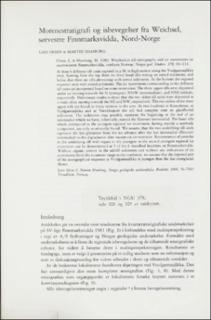| dc.contributor.author | Olsen, Lars | |
| dc.contributor.author | Hamborg, Martin | |
| dc.coverage.spatial | 19331 Suossjav'ri | |
| dc.coverage.spatial | 19324 Lavvoai'vi | |
| dc.coverage.spatial | 19323 Scagavar | |
| dc.coverage.spatial | 19322 Gav'dnjavarri | |
| dc.coverage.spatial | 19321 Niei'davarri | |
| dc.coverage.spatial | 18334 Mállejus | |
| dc.coverage.spatial | 18333 Raisjav'ri | |
| dc.coverage.spatial | KAUTOKEINO | |
| dc.coverage.spatial | KARASJOK | |
| dc.coverage.spatial | 18321 Siebe | |
| dc.coverage.spatial | 18322 Roavvoai'vi | |
| dc.coverage.spatial | 18323 Ur'devarri | |
| dc.coverage.spatial | 18332 Kautokeino | |
| dc.coverage.spatial | 18331 Carajav'ri | |
| dc.coverage.spatial | 19332 Gal'baj | |
| dc.date.accessioned | 2020-08-26T13:22:09Z | |
| dc.date.available | 2020-08-26T13:22:09Z | |
| dc.date.issued | 1983 | |
| dc.identifier.uri | https://hdl.handle.net/11250/2675139 | |
| dc.description.abstract | At least 6 different till units exposed in a 50 m high section along theVuolgamasjåkka river. Starting from the top there are three basal tillsresting on sorted sediments, and below that there are tills alternating withsorted sediments, and below that there are tills resting on sorted sediments.At the bottom the exposed sequence ends with sorted sediments. The icemovements corresponding to the different till units are interpreted based onstone orientation. The three pper tills were deposited under ice movingtowards the N (youngest), NNW (intermediate), and NNE (oldest), respectively.Preliminary results indicate that the two oldest till units were deposited asa result of ice moving towards the NE and NW, respectively. The two oldest ofthe three upper tills are found in many sections in the area. At twolocalities in Kautokeino, at Vuolgamasjåkka and at Vuoddasjavri the till bedcomplex rests on glacifluvial sediments. The sediments may possibly representthe last glaciation from the ice advance after the last interstadial (Eiravarriinterstadia) to the deglaciation after maximum ice extension. Reorientation ofparticles in the underlying till with regard to the youngest or the secondyoungest regional ice movement can be demonstrated at 5 of the 6 describedlocalities on Finnmarksvidda. Without organic content in the subtill sedimentsand without any indications of ice movements from the mountain range to thenorthwest, we assume that the exposed part of the stratigraphical sequence atVoulgamasjåkka is younger than the last interglacial (Eem). | |
| dc.language.iso | nor | |
| dc.relation.ispartofseries | NGU (378) | |
| dc.rights | Navngivelse 4.0 Internasjonal | |
| dc.rights.uri | http://creativecommons.org/licenses/by/4.0/deed.no | |
| dc.subject | BREBEVEGELSE | |
| dc.subject | MORENE | |
| dc.title | Morenestratigrafi og isbevegelser fra Weichsel, sørvestre Finnmarksvidda, Nord-Norge. | |
| dc.type | Journal article | |
| dc.description.localcode | 35946 | |
| dc.source.pagenumber | 93-113 | |

